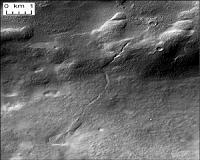 |
Pasadena CA (JPL) Jun 25, 2010 Minerals in northern Mars craters seen by two orbiters suggest that a phase in Mars' early history with conditions favorable to life occurred globally, not just in the south. Southern and northern Mars differ in many ways, so the extent to which they shared ancient environments has been open to question. In recent years, the European Space Agency's Mars Express orbiter and NASA's Mars Reconnaissance Orbiter have found clay minerals that are signatures of a wet environment at thousands of sites in the southern highlands of Mars, where rocks on or near the surface are about four billion years old. Until this week, no sites with those minerals had been reported in the northern lowlands, where younger volcanic activity has buried the older surface more deeply. French and American researchers report in the journal Science this week that some large craters penetrating younger, overlying rocks in the northern lowlands expose similar mineral clues to ancient wet conditions. "We can now say that the planet was altered on a global scale by liquid water about four billion years ago," said John Carter of the University of Paris, the report's lead author. Other types of evidence about liquid water in later epochs on Mars tend to point to shorter durations of wet conditions or water that was more acidic or salty. The researchers used the Compact Reconnaissance Imaging Spectrometer for Mars (CRISM), an instrument on the Mars Reconnaissance Orbiter, to check 91 craters in the northern lowlands. In at least nine, they found clays and clay-like minerals called phyllosilicates, or other hydrated silicates that form in wet environments on the surface or underground. Earlier observations with the OMEGA spectrometer on Mars Express had tentatively detected phyllosilicates in a few craters of the northern plains, but the deposits are small, and CRISM can make focused observations on smaller areas than OMEGA. "We needed the better spatial resolution to confirm the identifications," Carter said. "The two instruments have different strengths, so there is a great advantage to using both." CRISM Principal Investigator Scott Murchie of Johns Hopkins University Applied Physics Laboratory, Laurel, Md., a co-author of the new report, said that the findings aid interpretation of when the wet environments on ancient Mars existed relative to some other important steps in the planet's early history. The prevailing theory for how the northern part of the planet came to have a much lower elevation than the southern highlands is that a giant object slammed obliquely into northern Mars, turning nearly half of the planet's surface into the solar system's largest impact crater. The new findings suggest that the formation of water-related minerals, and thus at least part of the wet period that may have been most favorable to life, occurred between that early giant impact and the later time when younger sediments formed an overlying mantle. "That large impact would have eliminated any evidence for the surface environment in the north that preceded the impact," Murchie said. "It must have happened well before the end of the wet period." The report's other two authors are Francois Poulet and OMEGA Principal Investigator Jean-Pierre Bibring, both of the University of Paris. NASA's Jet Propulsion Laboratory, a division of the California Institute of Technology, Pasadena, manages the Mars Reconnaissance Orbiter for NASA. Johns Hopkins University Applied Physics Laboratory provided and operates CRISM, one of six instruments on that orbiter.
Share This Article With Planet Earth
Related Links Mars Reconnaissance Orbiter Mars News and Information at MarsDaily.com Lunar Dreams and more
 Brown Team Finds Widespread Glacial Meltwater Valleys On Mars
Brown Team Finds Widespread Glacial Meltwater Valleys On MarsProvidence RI (SPX) Jun 25, 2010 Planetary scientists have uncovered telltale signs of water on Mars - frozen and liquid - in the earliest period of the Red Planet's history. A new claim, made public this month, is that a deep ocean covered some of the northern latitudes. But the evidence for water grows much more scant after the Noachian era, which ended 3.5 billion years ago. Now Brown University planetary geologists ha ... read more |
|
| The content herein, unless otherwise known to be public domain, are Copyright 1995-2010 - SpaceDaily. AFP and UPI Wire Stories are copyright Agence France-Presse and United Press International. ESA Portal Reports are copyright European Space Agency. All NASA sourced material is public domain. Additional copyrights may apply in whole or part to other bona fide parties. Advertising does not imply endorsement,agreement or approval of any opinions, statements or information provided by SpaceDaily on any Web page published or hosted by SpaceDaily. Privacy Statement |